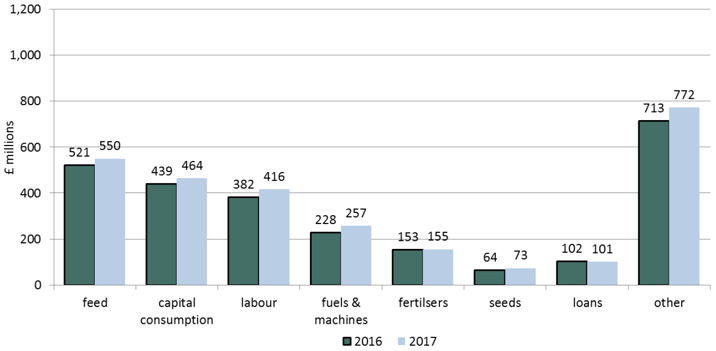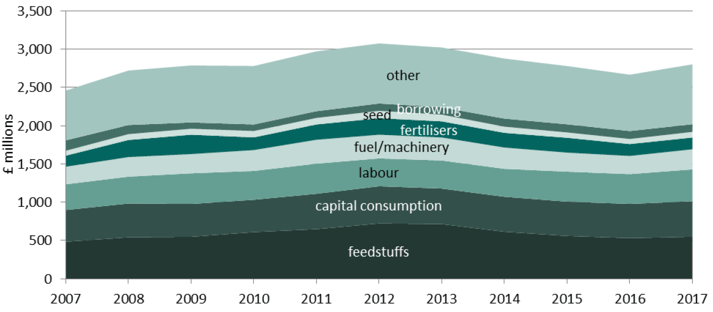Total income from farming: estimates for Scotland 2015-2017
The official measure of the net income gained by the agriculture industry in Scotland.
This document is part of a collection
6. Input costs faced by Scottish farms
Total costs for Scottish farms fell from £2.67 billion in 2015 to £2.62 billion in 2016, but then rose to an estimated £2.80 billion in 2017. Changes in costs will be due to both changes in volume and in prices.
Chart 7: Distribution of costs, 2016 and 2017 source: Table 1

The cost of feed was estimated as £521 million in 2016 (20 per cent of costs; down £18 million, three per cent or five per cent real terms) and £550 million in 2017 (20 per cent of costs; up £28 million, five per cent or four per cent real terms). Figures based mainly on the Farm Business Survey showed a two per cent reduction in the value of concentrates for sheep and cattle for 2016 and a similar reduction in roughages. There was also a two per cent fall calculated in granivore feed. Initial estimates for 2017, based on Agricultural Price Indices, livestock numbers and consideration of the grass harvested, suggest an increase in the bill, particularly for roughages.
Consumption of fixed capital, which in financial terms recognises the economic cost of using up a farm's previous capital investment (in livestock, buildings, plant and machinery), was estimated as £439 million in 2016 (17 per cent of costs; up £7 million, two per cent or steady in real terms) and £464 million in 2017 (17 per cent of costs; up £25 million, six per cent or four per cent real terms).
The cost of labour was estimated as £382 million in 2016 (15 per cent of costs; up £5 million, one per cent or a drop of one per cent in real terms) and £416 million in 2017 (15 per cent of costs; up £34 million, nine per cent or seven per cent real terms). Also included in this category is the cost of specialist contract work which was estimated as £7 million in 2016 and £6 million in 2017.
Chart 8: Input costs, in real terms, 2007 to 2017 source: Table 3

The cost of fuel was estimated as £108 million in 2016 (four per cent of costs; down £11 million, nine per cent or 11 per cent real terms) and £126 million in 2017 (four per cent of costs ; up £18 million, 17 per cent or 14 per cent real terms). The prices of red diesel and other fuels fell in 2016 but increased in 2017. Other machinery expenses and repairs amounted to a further £120 million in 2016 and £131 million in 2017.
The cost of fertiliser usage was estimated as £153 million in 2016 (six per cent of costs; down £34 million, 18 per cent or 20 per cent real terms) and £155 million in 2017 (six per cent of costs; up £2 million, one per cent or a one per cent fall in real terms). The estimated fall in 2016 was due mainly to price reductions, particularly for nitrogen.
Expenditure on seed, which only accounts for about two or three per cent of costs, was estimated as £64 million in 2016 and £73 million in 2017.
The cost of borrowing, split in the tables into FISIM (the costs of financial services) and interest (though both of these would appear, in practice, mainly as interest payments) fell slightly in 2016 and again in 2017, due mainly to the reductions in average interest rates.
All other expenses, including maintenance, veterinary fees, crop protection, rent and other miscellaneous expenses, fell £6 million to £707 million in 2016, but increased an estimated £62 million to £768 million in 2017.
Contact
There is a problem
Thanks for your feedback